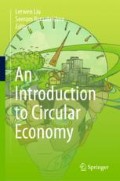Abstract
The area of circular economy in terms of organic waste in agriculture and food sector has always been challenging without an effective and efficient mechanism of collection and processing into value-added products. There is no circularity in food and agriculture unless the waste management process (for both production and consumption) is able to produce value-added and financially viable products, services and cash. Natural resources are used to grow agriculture products which are processed into food, bio-based materials and energy for consumption. In this process of production and consumption, waste is generated from post-harvesting, post-processing, pre-consumption and post-consumption. In the context of food, there is pre- and post-consumption food waste. Pre-consumption food waste can be edible food which can be recollected and resold or distributed to the needed consumer. The post-consumption food, the leftovers, can be processed together with the green waste into compost and soil enhancer which is then used by the agriculture sector to produce more food, and in so doing, the economic cycle is complete from food back to food.
Access this chapter
Tax calculation will be finalised at checkout
Purchases are for personal use only
References
Bellamy, K. (2019, December). Food to food program by VRM Biologik® (H. T. Khor, Interviewer).
Bellamy, K. (2020, December). Groundswell® continuous fermentation process (H. T. Khor, Interviewer).
Chan, C. (2019, December). Green Hero—Social enterprise combatting food wastage (H. T. Khor, Interviewer). George Town, Penang, Malaysia.
Chu, M. (2019, July 30). The star nation. Retrieved December 18, 2019, from Generation more waste than ever: https://www.thestar.com.my/news/nation/2019/07/30/generating-more-waste-than-ever.
Green Hero Team. (2019, December). Green Hero—Innovating for a greener future. Retrieved from Green Hero: www.greenhero.net.
Hong, G. T., Samah, M. A., Nowroji, K., & Chet, S. S. (2019). Food waste composting: Natural fermentation method. International Journal of Recent Technology and Engineering (IJRTE), 8(1C2).
Khor, H. T. (2012). Integrated Solid Waste Management (ISWM) for Penang—Implementation strategies. Submitted Penang State Government. George Town, Penang, Malaysia: Unpublished.
Kamal, M. Z. (2020, March 29). Chief Executive Officer, Mutiara Food Bank. Mutiara (H. T. Khor, Interviewer).
Khor, H. T. (2016). Penang organic waste management plan and policy: Climate & clean air coalition (CCAC). George Town, Penang. Retrieved from https://www.waste.ccacoalition.org/sites/default/files/files/1_report_on_penang_organic_waste_management_plan_plan_and_policy_0.pdf.
Low, A. (2018, December 23). Food bank goes nationwide. Retrieved from The Star: https://www.thestar.com.my/news/nation/2018/12/23/food-bank-goes-nationwide/.
Sekaran, R. (2017, November 20). Penang sets up food bank for the poor. Retrieved from The Star: https://www.thestar.com.my/news/nation/2017/11/20/penang-sets-up-food-bank-for-the-poor/.
Tan, C. (2018, December 22). Government launches food bank to aid the needy. Retrieved from Buletin Mutiara: https://www.buletinmutiara.com/govt-launches-food-bank-to-aid-the-needy/.
The Sun Daily. (2019, March 23). 48,850 households benefit from national Food Bank. Retrieved from https://www.thesundaily.my/local/48-850-households-benefit-from-national-food-bank-KY717059.
VRM international Pty. (2019, December). VRM Biologik. Retrieved from VRM Biologik: www.vrm.science.
Acknowledgements
The author would like to thank the following people for their inputs of data, photos and graphics in the various sections:
Case Study 1: Food to Food Programme by VRM Biologik® by Mr. Ken Bellamy, Founder of VRM Biologik®.
Case Study 2: From Food Waste to Farm Produce by Auto-City, Penang, Malaysia, authored by Mr. Gary Teoh King Hong, Managing Director, Golden Highway Auto-City Sdn Bhd, Penang, Malaysia.
Case Study 3: Green Hero—Youth Social Enterprise Combatting Food Wastage by Calvin Chan, Chief Environmental Officer (CEO) and Founder of Green Hero.
Case Study 4: Mutiara Food Bank Diverting Edible Food to the Needy (Government) by Mr. Muhammad Zakwan Mustafa Kamal. Chief Executive Officer, Mutiara Food Bank.
Special thanks to Ms. Sawaras Thongkaew, STEAM Platform for her hard work in providing the illustrations for Fig. 1: Circular economy for food and agriculture and Fig. 9: Green Hero operation flowchart.
Author information
Authors and Affiliations
Corresponding authors
Editor information
Editors and Affiliations
Rights and permissions
Copyright information
© 2021 Springer Nature Singapore Pte Ltd.
About this chapter
Cite this chapter
Khor, H.T., Teoh, G.K.H. (2021). Agriculture and Food Circularity in Malaysia. In: Liu, L., Ramakrishna, S. (eds) An Introduction to Circular Economy. Springer, Singapore. https://doi.org/10.1007/978-981-15-8510-4_7
Download citation
DOI: https://doi.org/10.1007/978-981-15-8510-4_7
Published:
Publisher Name: Springer, Singapore
Print ISBN: 978-981-15-8509-8
Online ISBN: 978-981-15-8510-4
eBook Packages: EngineeringEngineering (R0)

